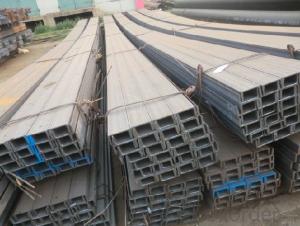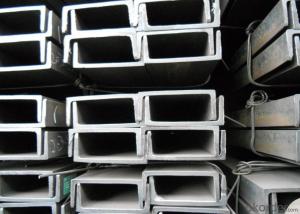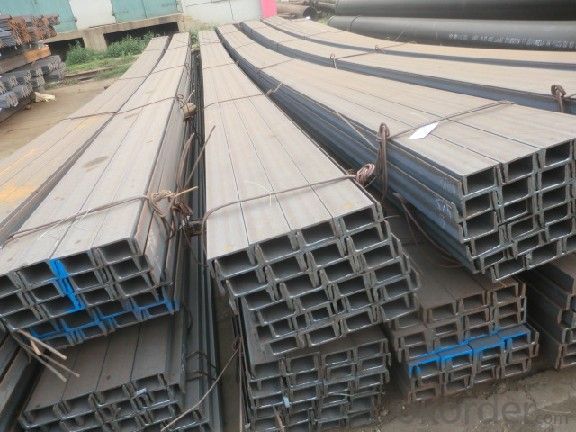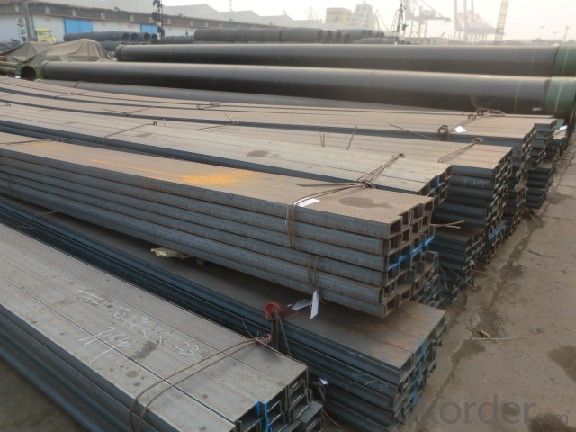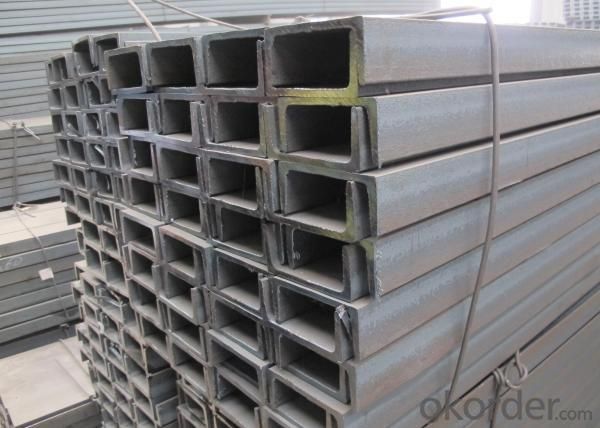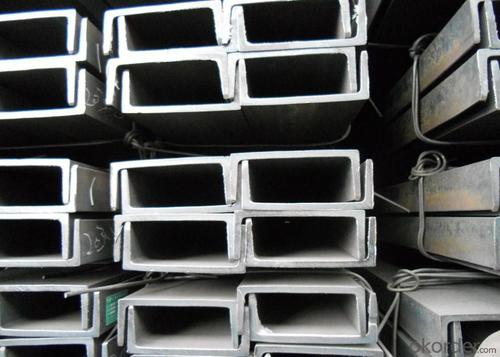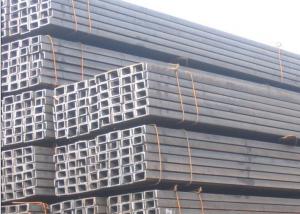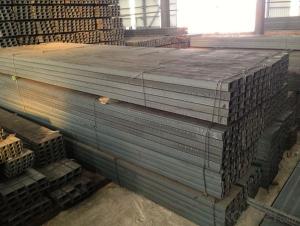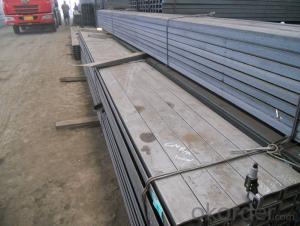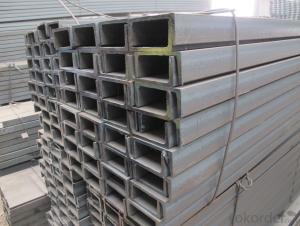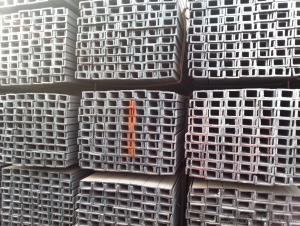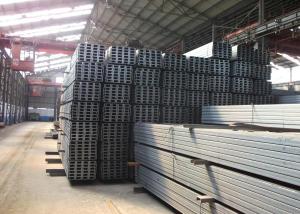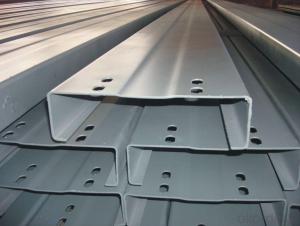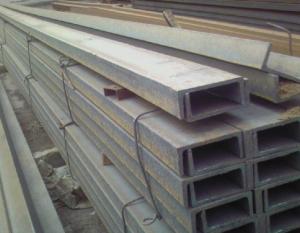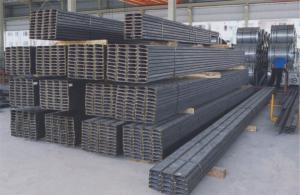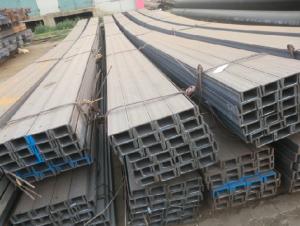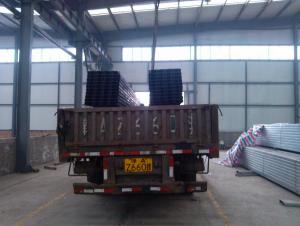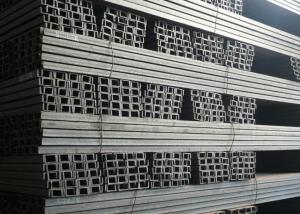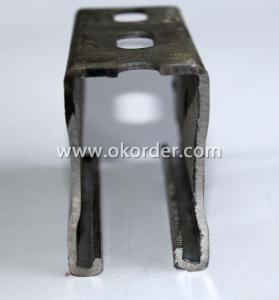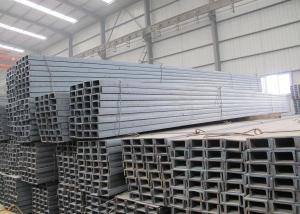GB Standard, IS Standard Steel U Channel
- Loading Port:
- Tianjin
- Payment Terms:
- TT OR LC
- Min Order Qty:
- 25 m.t
- Supply Capability:
- 20000 m.t/month
OKorder Service Pledge
OKorder Financial Service
You Might Also Like
Product Description:
OKorder is offering GB Standard, IS Standard Steel U Channelat great prices with worldwide shipping. Our supplier is a world-class manufacturer of steel, with our products utilized the world over. OKorder annually supplies products to European, North American and Asian markets. We provide quotations within 24 hours of receiving an inquiry and guarantee competitive prices. The steel u channel can be applied to construction of warehouses, workshops, sport stadiums and car parks etc. In details, the steel u channel belongs to carbon structural steel which is applied to in the field of construction and machinery. The steel u channel is usually used for arch-itechtural structure, and they could be welded in order to support or hang a vari-ety of facilities. They are also usually used in combination with I beam. Generally,the steel u channel must possess perfect welding property, riveting property and mechanical property and so on.
Product Applications:
GB Standard, IS Standard Steel U Channel are ideal for structural applications and are widely used in the construction of buildings and bridges, and the manufacturing, petrochemical, and transportation industries.
Product Advantages:
OKorder's GB Standard, IS Standard Steel U Channel are durable, strong, and resist corrosion.
Main Product Features:
· Premium quality
· Prompt delivery & seaworthy packing (30 days after receiving deposit)
· Corrosion resistance
· Can be recycled and reused
· Mill test certification
· Professional Service
· Competitive pricing
Product Specifications:
Specifications of Steel U Channel:
Standard Applied: GB Standard, EN Standard(UPN), JIS Standard
Sizes: 50mm to 300mm
Material Grade: Q235B, Q345B, S235JR, SS400, ASTM A36
As shown in the figure:
JIS U CHANNEL | Standard h | Sectional b | Dimension s | t | Mass: Kg/m |
(mm) | (mm) | (mm) | (mm) | ||
50x25 | 50 | 25 | 3.0 | 6.00 | 2.37 |
75X40 | 75 | 40 | 3.8 | 7.00 | 5.30 |
75X40 | 75 | 40 | 4.0 | 7.00 | 5.60 |
75X40 | 75 | 40 | 4.5 | 7.00 | 5.85 |
75X40 | 75 | 40 | 5.0 | 7.00 | 6.92 |
100X50 | 100 | 50 | 3.8 | 6.00 | 7.30 |
100X50 | 100 | 50 | 4.2 | 6.00 | 8.03 |
100X50 | 100 | 50 | 4.5 | 7.50 | 8.97 |
100X50 | 100 | 50 | 5.0 | 7.50 | 9.36 |
125X65 | 125 | 65 | 5.2 | 6.80 | 11.66 |
125X65 | 125 | 65 | 5.3 | 6.80 | 12.17 |
125X65 | 125 | 65 | 5.5 | 8.00 | 12.91 |
125X65 | 125 | 65 | 6.0 | 8.00 | 13.40 |
150x75 | 150 | 75 | 5.5 | 7.30 | 14.66 |
150x75 | 150 | 75 | 5.7 | 10.00 | 16.71 |
150x75 | 150 | 75 | 6.0 | 10.00 | 17.90 |
150x75 | 150 | 75 | 6.5 | 10.00 | 18.60 |
Note: We are able to supply other dimensions and sizes, which depends on the customer's requirements for the quantity.
Chemical Composition of Q235B Steel U Channel:
Alloy No | Grade | Element(%) | ||||
C | Mn | S | P | Si | ||
Q235 | B | 0.12-0.20 | 0.3-0.7 | ≦0.045 | ≦0.045 | ≦0.3 |
Physical Properties of Q235B Steel U Channel:
Grade | Yielding Strength Point(Mpa) | ||||
Q235B | Thickness(mm) | ||||
≦16 | >16-40 | >40-60 | >60-100 | ||
≧235 | ≧225 | ≧215 | ≧205 | ||
Tensile Strength(Mpa) | Elongation After Fracture(%) | ||||
Thickness(mm) | |||||
≦16 | >16-40 | >40-60 | >60-100 | ||
375-500 | ≧26 | ≧25 | ≧24 | ≧23 | |
FAQ:
Q1: Why buy Materials & Equipment from OKorder.com?
A1: All products offered byOKorder.com are carefully selected from China's most reliable manufacturing enterprises. Through its ISO certifications, OKorder.com adheres to the highest standards and a commitment to supply chain safety and customer satisfaction.
Q2: Can fit in the containers of 20fts the steel beams of 6M?
A2: No proble, we can put them into the containers in the form sideling.
Q3: The products are invoicing on theoritical weight or on actual weight?
A3: We can do it in both manners, according to the customers' request.
Images:
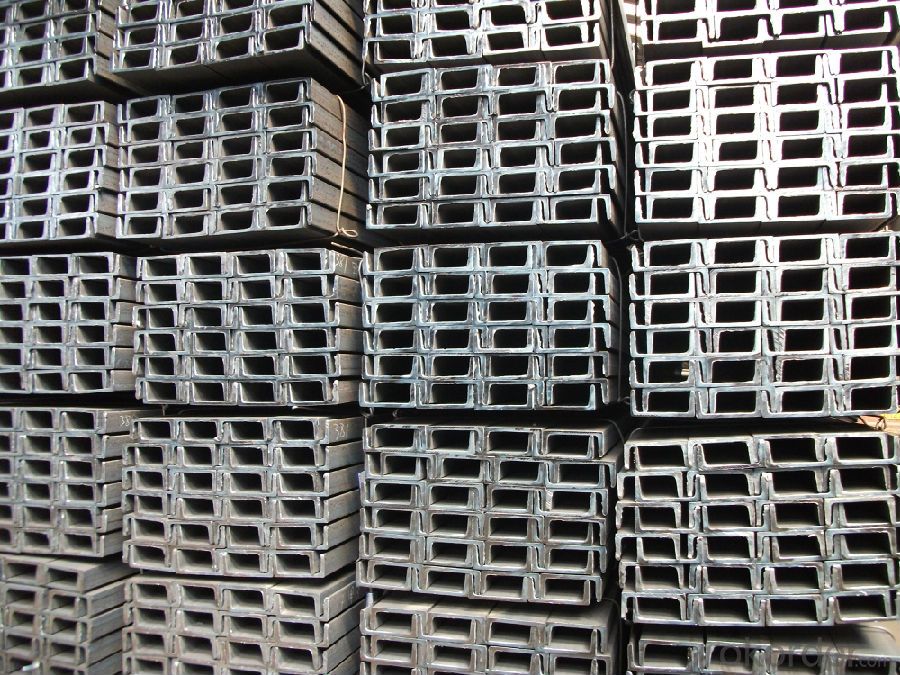
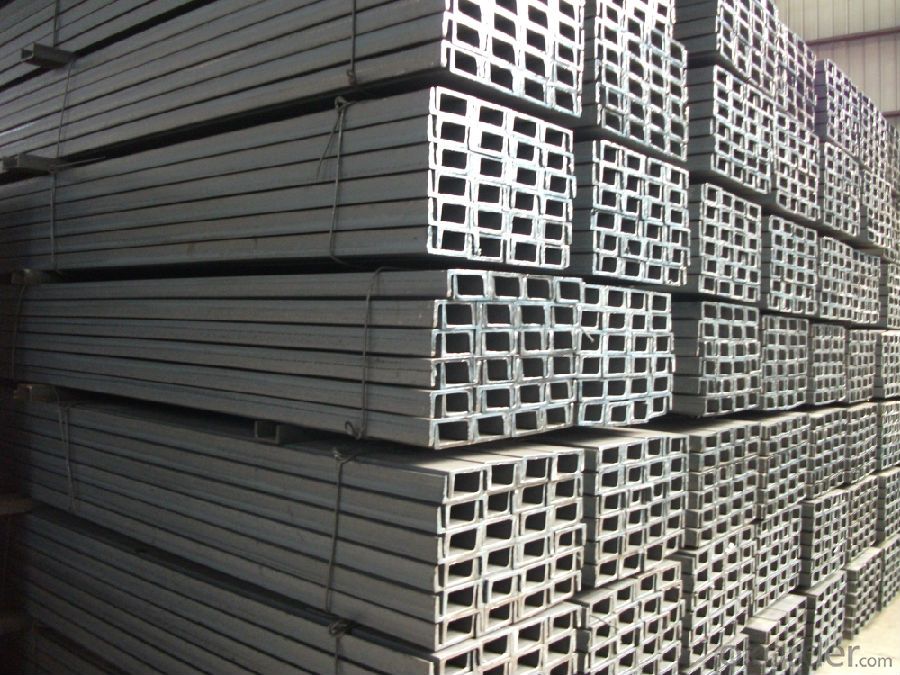
- Q: How do steel channels contribute to the overall safety of a structure?
- Steel channels contribute to the overall safety of a structure in several ways. Firstly, steel channels provide structural support and stability to the building. They are often used as load-bearing members in the construction industry, helping to distribute the weight of the structure evenly and efficiently. This ensures that the building can withstand various external forces such as wind, earthquakes, and heavy loads without collapsing. By providing a strong framework, steel channels enhance the overall safety and structural integrity of the building. Secondly, steel channels play a crucial role in fire safety. Steel is a non-combustible material, and when used as channels, it can help prevent the spread of fire within a structure. In the event of a fire, steel channels act as fire barriers, restricting the movement of flames and heat to specific areas. This containment helps to limit the damage caused by fire and provides occupants with more time to evacuate safely. Additionally, steel channels are resistant to corrosion and deterioration, making them highly durable and reliable. Unlike other materials, steel does not rot, warp, or degrade over time. This longevity ensures that the structure remains stable and secure in the long run, reducing the risk of accidents and structural failures. Furthermore, steel channels are often used in the construction of seismic-resistant structures. With their high strength and flexibility, steel channels can absorb and dissipate seismic energy during an earthquake. This ability to withstand seismic forces helps to minimize structural damage and ensures the safety of the occupants within the building. In conclusion, steel channels contribute significantly to the overall safety of a structure by providing structural support, fire resistance, durability, and seismic resistance. Their use in construction enhances the stability, strength, and integrity of the building, ensuring the safety and well-being of its occupants.
- Q: Are steel channels suitable for modular partition systems?
- Yes, steel channels are suitable for modular partition systems. Steel channels provide structural strength and stability required for modular partitions, allowing for easy installation and customization. They also offer durability and can withstand the weight of partition panels, ensuring long-lasting performance. Additionally, steel channels can be easily integrated with other components of the partition system, making them a suitable choice for modular applications.
- Q: UAP300 what channel? What specifications?. You great God to explain ah. I am indebted forever urgently.. Thank you ~!
- In order to accomplish the task. I'm sorry
- Q: What is the elastic modulus of steel?
- The general definition of the modulus of elasticity is that the stresses in the one-way stress state are divided by the strain in that direction.
- Q: Is section steel the same as channel steel?
- Dissimilarity。 Channel steel is a kind of section steel. Section steel includes angle steel, channel steel, I-beam, H steel and so on
- Q: 16A channel steel size requirements are national standards Oh!
- Height 160, width 63, wall thickness 6.5, theoretical weight 17.24KG/M
- Q: What are the different grades of steel used for channels?
- Channels are commonly made from various grades of steel. The choice of steel grade depends on the desired properties and intended application. A36 steel is one grade that is frequently utilized. It is a low carbon steel known for its versatility and excellent weldability. Due to its strength and durability, it is often employed in structural applications, such as channels. Another grade that is commonly used is A572 steel. This is a high-strength, low-alloy steel that offers improved strength and corrosion resistance compared to A36 steel. It is suitable for demanding applications, including heavy-duty construction projects. Additional grades of steel that may be employed for channels include A588 steel, which is known for its corrosion resistance in weathering conditions, and A500 steel, which is a structural steel often used in construction and infrastructure projects. To determine the most suitable grade of steel for a specific channel application, it is important to consult with a structural engineer or steel supplier. Factors such as load-bearing capacity, corrosion resistance, and environmental conditions should be taken into consideration.
- Q: What are the different types of fire protection for steel channels?
- Steel channels have various fire protection options available, each with its own advantages and limitations. 1. Intumescent coatings: Applied to the surface of the steel channel, these coatings expand when exposed to high temperatures. This expansion forms a protective layer that insulates the steel and slows down heat transfer. Intumescent coatings offer passive fire protection, withstanding fire for a specified duration, typically ranging from 30 minutes to several hours. 2. Fire-resistant boards: Constructed from mineral fibers or cementitious materials, these boards are installed around the steel channels to provide fire resistance. They act as a barrier, preventing heat from reaching the steel and maintaining its structural integrity. Fire-resistant boards also offer thermal insulation and soundproofing capabilities. 3. Fireproofing sprays: These sprays are applied to the steel channels, forming a protective layer. Typically made of cementitious materials like gypsum or vermiculite, they can withstand high temperatures and prevent the steel from reaching critical levels. Fireproofing sprays are suitable for both indoor and outdoor applications. 4. Encasement: Another option is to encase the steel channels in concrete or masonry, offering a high level of fire protection. The encasement acts as a barrier, insulating the steel from heat and preventing it from reaching critical temperatures. This method is commonly used in construction projects with strict fire resistance requirements. It is important to consider factors such as the required fire resistance rating, building type, and specific application when choosing a fire protection method. Consultation with fire protection experts and adherence to local building codes and regulations are essential to ensure appropriate fire protection measures are implemented for steel channels.
- Q: What are the applications of steel channels in construction?
- Steel channels have a wide range of applications in construction. They are commonly used as structural components in buildings, bridges, and infrastructure projects. These channels provide support and stability, helping to distribute the load and resist bending or twisting forces. They are also used for framing, reinforcing concrete structures, and creating architectural details. Overall, steel channels play a crucial role in enhancing the strength, durability, and safety of various construction projects.
- Q: How do steel channels contribute to LEED certification?
- Steel channels can contribute to LEED certification by fulfilling various sustainable building requirements. They can aid in achieving points in the Materials and Resources category, as steel channels are often made from recycled materials and, when their lifespan is over, can be easily recycled again. Additionally, steel channels can contribute to energy efficiency and indoor air quality, as they can be used in the construction of energy-efficient building envelopes and HVAC systems. Moreover, steel channels are durable, long-lasting, and low-maintenance, reducing the need for replacements or repairs, thus minimizing waste generation. Overall, incorporating steel channels in a construction project can enhance its sustainability and help in obtaining LEED certification.
Send your message to us
GB Standard, IS Standard Steel U Channel
- Loading Port:
- Tianjin
- Payment Terms:
- TT OR LC
- Min Order Qty:
- 25 m.t
- Supply Capability:
- 20000 m.t/month
OKorder Service Pledge
OKorder Financial Service
Similar products
Hot products
Hot Searches
Related keywords
